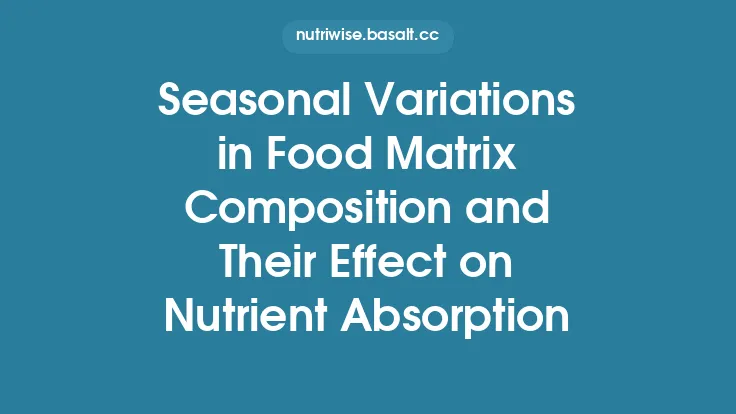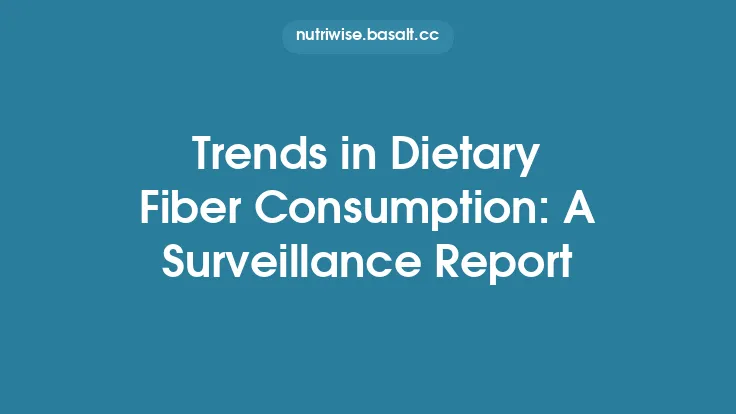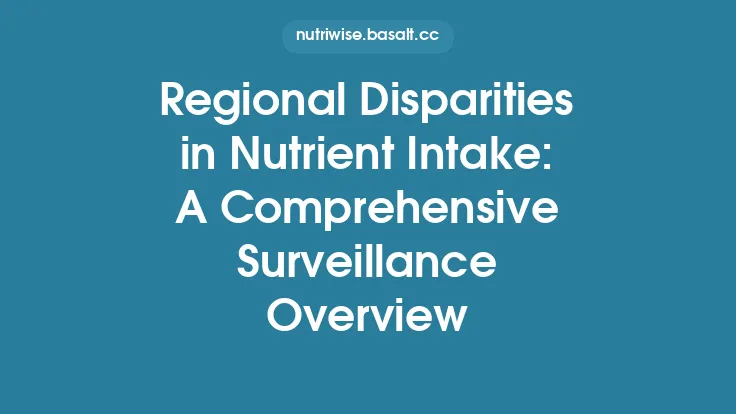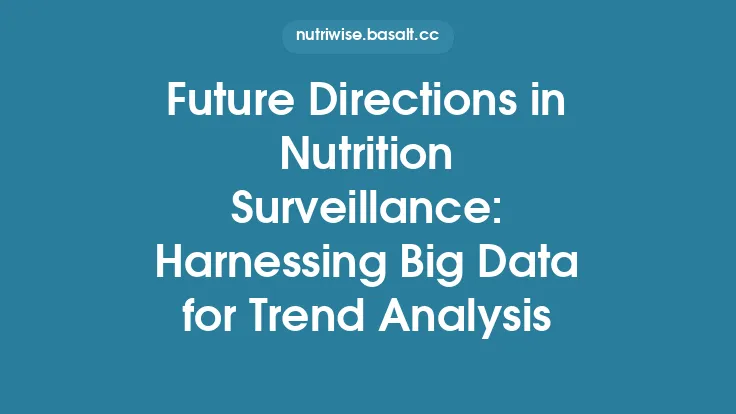Seasonal shifts in climate, agricultural cycles, cultural festivities, and food‑availability patterns exert a profound influence on what populations eat throughout the year. Nutrition surveillance systems—whether they are continuous household surveys, sentinel site monitoring, or digital food‑purchase tracking—provide the longitudinal data needed to detect, quantify, and interpret these fluctuations. By integrating seasonal analyses into routine surveillance, public‑health authorities can move beyond static snapshots of dietary intake and develop timely, context‑specific interventions that safeguard nutrient adequacy and support food‑system resilience.
Understanding the Drivers of Seasonal Food Consumption
Agricultural production cycles
Crop calendars dictate the timing of harvests for staple grains, fruits, and vegetables. In temperate regions, the post‑harvest period often coincides with a surge in fresh produce consumption, whereas winter months may see a reliance on stored roots, tubers, and preserved foods. In tropical zones, multiple cropping seasons can create overlapping peaks of availability, but also periods of scarcity when rains fail or pests damage yields.
Cultural and religious calendars
Festivals, holidays, and religious observances introduce predictable spikes in the intake of specific food groups. For example, fasting periods may temporarily reduce animal‑source foods, while celebratory feasts can increase consumption of high‑energy dishes, sweets, and animal products. These culturally driven patterns are reproducible year after year and can be captured through surveillance timestamps.
Economic and market dynamics
Seasonal price fluctuations affect purchasing power and food choices. When fresh produce is abundant, market prices typically fall, encouraging higher fruit and vegetable intake. Conversely, price spikes during off‑season periods can push consumers toward cheaper, energy‑dense alternatives such as refined grains, oils, and processed snacks.
Environmental factors
Temperature, daylight length, and weather extremes influence appetite and food preferences. Cold weather often drives higher intake of hot, energy‑dense meals, while hot seasons may increase consumption of hydrating foods and beverages, including soups, salads, and fruit juices.
Surveillance Methodologies for Capturing Seasonal Variation
Repeated cross‑sectional household surveys
Conducting the same dietary questionnaire at multiple points across the calendar year enables the detection of intra‑annual trends. To maximize comparability, surveys should use standardized instruments (e.g., 24‑hour recalls, multiple‑pass methods) and maintain consistent sampling frames throughout the year.
Panel designs and longitudinal cohorts
Following the same households or individuals over time provides a powerful lens on seasonal dynamics, allowing analysts to separate true seasonal effects from cohort‑specific behaviors. Panel attrition must be mitigated through robust follow‑up protocols and incentives.
Sentinel site monitoring
Strategically placed sentinel sites—such as school canteens, workplace cafeterias, or community markets—can deliver high‑frequency data on food purchases and consumption. When these sites are geographically and socio‑economically diverse, they serve as proxies for broader population trends.
Digital and big‑data streams
Retail scanner data, mobile food‑logging apps, and point‑of‑sale systems generate near‑real‑time information on food purchases. By aggregating these data at the regional or national level and aligning timestamps with calendar seasons, analysts can produce fine‑grained seasonal consumption curves.
Biomarker integration
Seasonal changes in nutrient status can be corroborated with biological markers (e.g., serum ferritin, plasma carotenoids). While biomarkers are not the primary focus of this article, their periodic measurement can validate dietary surveillance findings and highlight periods of heightened deficiency risk.
Analytical Approaches to Quantify Seasonal Patterns
Time‑series decomposition
Applying additive or multiplicative decomposition separates observed intake data into trend, seasonal, and irregular components. This technique clarifies the magnitude and timing of seasonal peaks and troughs, facilitating comparison across years.
Fourier and wavelet analysis
For complex or non‑stationary seasonal signals, spectral methods such as Fourier transforms or wavelet analysis can identify dominant periodicities and assess how they evolve over time.
Mixed‑effects modeling
Hierarchical models that incorporate random effects for individuals or households, and fixed effects for season, temperature, and price indices, allow for the estimation of season‑specific intake adjustments while accounting for within‑subject correlation.
Seasonal index calculation
A simple yet informative metric, the seasonal index expresses the ratio of average intake in a given month to the overall annual mean. Indices above 1 indicate above‑average consumption, while values below 1 denote deficits.
Key Findings from Global Surveillance Efforts
- Fruit and vegetable intake typically peaks during the local harvest months, with seasonal indices ranging from 1.2 to 1.5 in temperate regions and 1.1 to 1.3 in tropical zones.
- Animal‑source foods (meat, dairy, eggs) often display modest seasonal variation, but notable spikes align with cultural festivals that emphasize feasting.
- Energy density of diets rises in colder months, driven by increased consumption of starchy staples, added fats, and sugary beverages.
- Processed snack consumption shows a counter‑seasonal pattern, increasing during school holidays and summer vacation periods when structured meals are less frequent.
- Micronutrient‑rich foods (e.g., leafy greens, berries) experience pronounced seasonal gaps, correlating with higher prevalence of subclinical deficiencies during off‑season periods.
Public‑Health Implications of Seasonal Consumption Patterns
Nutrient adequacy and deficiency risk
Seasonal dips in fruit, vegetable, and fish intake can lead to temporary shortfalls in vitamins (A, C, folate) and minerals (iron, iodine). Surveillance data enable health agencies to anticipate these windows and deploy targeted supplementation or fortification campaigns.
Food‑security planning
Understanding when households are most reliant on stored or processed foods helps policymakers design seasonal safety‑net programs, such as cash transfers timed to coincide with post‑harvest price drops or pre‑harvest scarcity.
Behavioral interventions
Season‑specific nutrition education—e.g., promoting warm, vegetable‑rich soups in winter or encouraging hydration and fruit consumption in summer—can align messaging with prevailing dietary habits, increasing relevance and uptake.
Supply‑chain optimization
Retailers and distributors can use seasonal consumption forecasts to adjust inventory, reduce food waste, and ensure the availability of nutrient‑dense options throughout the year.
Case Illustrations
Northern Europe: Winter Vitamin C Gap
Surveillance across three Nordic countries revealed a 30 % reduction in fresh citrus and berry consumption during December–February, coinciding with a modest rise in respiratory infections. A coordinated public‑health response introduced fortified winter beverages and community‑based distribution of vitamin‑C‑rich preserved fruits, attenuating the seasonal deficiency.
Southeast Asia: Monsoon‑Driven Rice Consumption Spike
In a large‑scale panel study, rice intake surged by 18 % during the monsoon months, reflecting reduced availability of fresh vegetables and increased reliance on stored staples. The surveillance system flagged this shift, prompting the Ministry of Agriculture to accelerate the release of drought‑tolerant vegetable varieties, thereby smoothing the seasonal intake curve.
South America: Festival‑Related Red Meat Surge
Analysis of point‑of‑sale data around the annual “Carnaval” period showed a 45 % increase in red‑meat purchases over a two‑week window. Nutrition surveillance linked this spike to a temporary rise in saturated fat intake, informing a brief public‑health advisory that emphasized portion control and inclusion of plant‑based side dishes.
Recommendations for Strengthening Seasonal Surveillance
- Standardize temporal granularity – Adopt a minimum quarterly data collection frequency, with monthly or weekly sampling where resources permit, to capture short‑term fluctuations.
- Integrate price and climate data – Linking dietary records with market price indices and meteorological variables enriches causal inference and improves predictive modeling.
- Leverage technology – Mobile‑based 24‑hour recalls and barcode scanning apps can reduce respondent burden and increase data timeliness, especially in remote settings.
- Promote open data sharing – Establishing regional repositories for seasonal consumption data encourages cross‑country comparisons and meta‑analyses.
- Build capacity for advanced analytics – Training surveillance teams in time‑series and mixed‑effects modeling ensures robust interpretation of seasonal patterns.
- Align with policy cycles – Synchronize surveillance reporting with budgeting and program‑planning timelines so that seasonal insights directly inform resource allocation.
Future Directions
- Dynamic forecasting models that combine real‑time retail data, satellite‑derived crop forecasts, and climate projections could predict upcoming seasonal intake shifts weeks in advance.
- Personalized nutrition feedback delivered via mobile platforms may adapt recommendations to an individual’s seasonal context, enhancing relevance and adherence.
- Cross‑sectoral collaborations between agriculture, health, and commerce ministries will be essential to translate surveillance findings into coordinated actions that mitigate seasonal nutrition gaps.
By embedding a seasonal lens within nutrition surveillance, researchers and policymakers gain a more nuanced, actionable picture of dietary behavior. This perspective not only uncovers periodic vulnerabilities but also highlights opportunities to harness seasonal abundance, ultimately fostering a more resilient and health‑promoting food environment year‑round.





